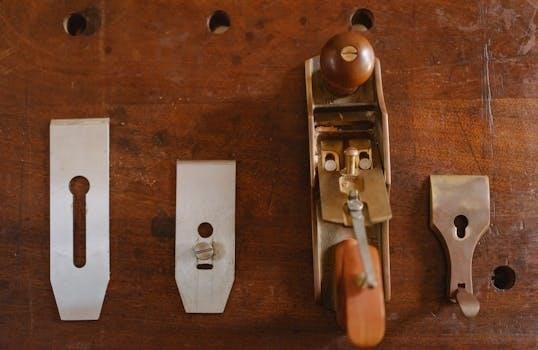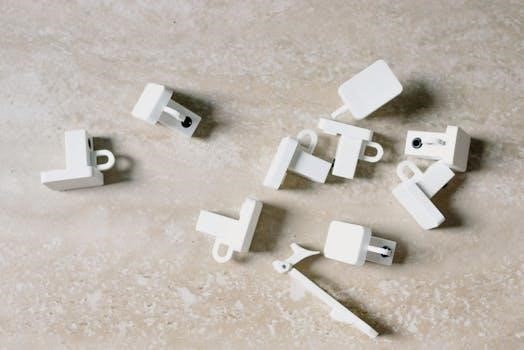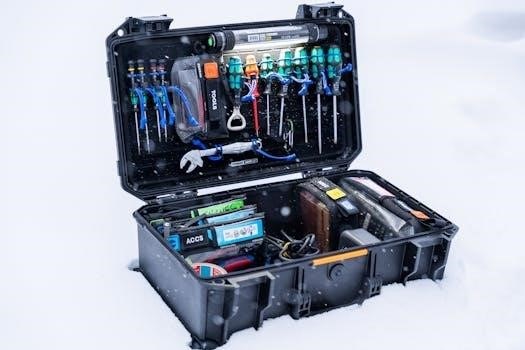Permatex Windshield Repair Kit Instructions⁚ A Comprehensive Guide
This comprehensive guide offers detailed‚ step-by-step instructions for utilizing the Permatex Windshield Repair Kit․ Learn to effectively mend minor chips and cracks in laminated windshields‚ achieving professional-level outcomes․ We’ll explore preparation‚ application‚ curing‚ and aftercare techniques for lasting repairs․
The Permatex Windshield Repair Kit offers a do-it-yourself solution for fixing minor damage‚ such as bullseyes and star damage‚ on laminated windshield glass․ This kit provides an accessible and cost-effective alternative to professional repairs for small chips and cracks․ It’s designed for ease of use‚ even for those with limited experience in auto repairs․ The kit includes all necessary components and easy-to-follow instructions with photographs‚ making the repair process straightforward․ By using this kit‚ you can restore the structural integrity of your windshield‚ preventing further cracking and saving time and money․ The advanced resin creates a strong bond‚ sealing and filling the damage effectively․
Kit Contents and Overview
The Permatex Windshield Repair Kit includes essential components for repairing minor windshield damage․ Typically‚ you’ll find a resin applicator‚ a syringe with a plunger‚ and a supply of the specially formulated resin itself․ Also included are clear adhesive curing strips to protect and finalize the repair․ Detailed instructions‚ often with accompanying photographs‚ guide you through each step․ The kit is designed for repairing bullseyes and star-shaped breaks‚ and small chips․ This comprehensive set provides everything needed to complete a professional-looking repair‚ sealing the damage and preventing it from spreading․ Ensure all parts are present before starting․
Preparing for the Repair
Before starting the repair process‚ thorough preparation is crucial for optimal results․ Begin by carefully inspecting the damage to determine if it’s suitable for a DIY repair․ Clean the damaged area of the windshield‚ removing any loose glass or debris․ Ensure the windshield is dry before proceeding․ It’s best to perform the repair in a shaded area‚ avoiding direct sunlight during the initial application; The ideal temperature range for application is between 50°F and 75°F (10°C to 25°C)․ Gather all the kit components and read the instructions carefully before beginning․ Proper preparation sets the stage for a successful and lasting repair․
Cleaning the Damaged Area
Prior to applying the repair resin‚ meticulous cleaning of the damaged area is essential․ Use a clean‚ dry cloth or paper towel to gently wipe away any loose glass fragments‚ dirt‚ or debris from the impact point and surrounding area․ For stubborn residue‚ you can dampen the cloth with a small amount of glass cleaner‚ ensuring it doesn’t leave any streaks or film․ Allow the area to dry completely before proceeding․ Avoid using excessive pressure‚ as this could worsen the damage․ A clean surface ensures proper adhesion of the repair resin and a more effective‚ long-lasting repair․ Do not use the resin to clean․
Ideal Temperature and Conditions
Achieving optimal results with the Permatex Windshield Repair Kit necessitates adhering to specific environmental conditions․ Conduct the repair in a shaded area to prevent premature curing of the resin from direct sunlight․ The ideal windshield temperature should be between 50°F and 75°F (10°C to 25°C)․ Avoid performing the repair in extremely hot or cold conditions‚ as this can affect the resin’s viscosity and curing process․ Ensure the windshield is dry and free from moisture․ These conditions promote proper resin flow and bonding‚ leading to a stronger and more transparent repair‚ maximizing the kit’s effectiveness and longevity of the repair․
Step-by-Step Instructions
Follow these instructions carefully for successful windshield repair using the Permatex kit․ Begin by thoroughly cleaning the damaged area․ Next‚ attach the applicator to the windshield‚ centering it over the chip or crack․ Carefully introduce the resin into the applicator․ Utilize the syringe to extract any trapped air‚ ensuring complete resin penetration․ Apply pressure using the syringe‚ forcing the resin into the damage․ Subsequently‚ release the pressure and let the resin settle․ Allow the resin to cure fully in direct sunlight‚ and finally‚ remove any excess resin‚ and apply the curing strips․ Careful adherence to these steps ensures a strong‚ clear repair․
Applying the Applicator and Resin

Carefully position the applicator directly over the damaged area of the windshield‚ ensuring the bullseye or star damage is centered within the applicator’s opening․ Firmly attach the applicator to the glass using the provided suction cups‚ ensuring a secure and airtight seal․ Next‚ slowly introduce the Permatex resin into the applicator chamber‚ filling it according to the kit’s instructions․ Avoid overfilling‚ which can create bubbles․ Allow the resin to settle for a moment‚ ensuring it’s ready for the next step‚ which involves using the syringe to remove air and inject the resin deeper into the damage for effective repair․
Using the Syringe for Air Removal and Resin Injection
Insert the syringe into the applicator chamber‚ ensuring a tight connection․ Gently pull back on the syringe plunger to extract any trapped air bubbles from within the damaged area and the applicator․ This vacuum action helps the resin penetrate effectively․ After air removal‚ slowly depress the syringe plunger to inject the resin into the chip or crack․ Apply steady pressure to force the resin deep into the damaged area․ Repeat the process of air removal and resin injection several times‚ ensuring thorough saturation․ Allow the resin to sit for a few minutes to maximize penetration before proceeding further․
Pressure Application and Release
After injecting the resin‚ maintain pressure on the syringe plunger for a specified duration‚ typically around 10-15 minutes․ This sustained pressure ensures the resin fully permeates the damaged area‚ filling all voids and cracks․ Following the pressure application‚ carefully release the plunger‚ allowing any remaining air or excess resin to escape․ Observe the repair area for any signs of air bubbles or incomplete filling․ If necessary‚ repeat the resin injection and pressure application process․ Proper pressure application is crucial for achieving a strong and durable repair‚ minimizing the visibility of the damage․
Curing the Resin
The Permatex Windshield Repair Kit utilizes a UV-curing resin that hardens upon exposure to sunlight․ Once the resin has been properly applied and the air removed‚ the next crucial step is to cure the resin effectively․ This process involves exposing the repaired area to direct sunlight‚ allowing the UV rays to activate the resin and initiate the hardening process․ The duration of the curing process is dependent on factors such as the intensity of the sunlight and the ambient temperature; Proper curing is essential for achieving a durable and long-lasting repair of the windshield damage․
Sunlight Curing Process
The Permatex resin cures through exposure to ultraviolet (UV) rays‚ primarily from sunlight․ Position the repaired windshield area directly under sunlight․ The UV rays trigger a chemical reaction‚ hardening the resin․ Ensure the sunlight hits the repaired area without obstruction․ If direct sunlight isn’t available‚ a UV lamp can substitute․ Curing time varies‚ influenced by sunlight intensity and ambient temperature․ Warmer‚ sunnier days expedite curing․ Shield the surrounding area to avoid unintended resin hardening․ Patience during this stage is crucial for a robust and transparent repair‚ ensuring structural integrity and optical clarity of the windshield․
Curing Time Considerations
Curing time for the Permatex resin depends on several factors․ Primarily‚ sunlight intensity directly impacts curing speed; bright‚ sunny conditions accelerate the process․ Ambient temperature also plays a role‚ with warmer temperatures generally shortening curing time․ Expect longer curing durations on cloudy days or in cooler climates․ Typically‚ curing ranges from 30 minutes to several hours․ Extended exposure to sunlight beyond the recommended time won’t harm the repair․ To ensure thorough hardening‚ err on the side of caution and allow ample curing time․ Avoid touching or disturbing the repaired area during curing․ A fully cured resin is vital for a lasting and effective repair․
Finishing Touches

Once the resin has fully cured under sunlight‚ the final steps involve refining the repair for optimal clarity and appearance․ Carefully remove the applicator and any remaining adhesive tabs from the windshield surface․ Use a razor blade held at a low angle to gently scrape away any excess‚ hardened resin surrounding the repair site․ Be cautious not to scratch the surrounding glass․ Clean the area with a glass cleaner for enhanced visibility․ Applying the curing strips helps create a smooth‚ even surface․ These finishing touches are key to achieving a professional-looking and durable windshield repair‚ enhancing the aesthetic appeal and integrity․

Removing Excess Resin
After the resin has properly cured‚ the next step is to carefully remove any excess material from the windshield surface․ Use a sharp razor blade‚ holding it at a shallow angle to the glass․ Gently scrape away the excess resin‚ being mindful not to scratch the surrounding windshield area․ Work slowly and methodically to achieve a smooth‚ even surface․ Ensure all remnants of the resin are removed to prevent any visual distortion or obstruction․ Clean the area thoroughly with a glass cleaner to remove any residual debris‚ leaving a clear and polished finish for optimal visibility and aesthetic appeal․
Applying Curing Strips
Once the excess resin has been removed‚ the next step is to apply the curing strips․ These transparent strips help to ensure the resin fully hardens and bonds correctly with the glass․ Carefully place a curing strip directly over the repaired area‚ pressing it down firmly to eliminate any air bubbles․ The strip should completely cover the repaired area and extend slightly beyond its edges․ This creates a smooth‚ even surface that facilitates optimal curing․ Expose the treated area with the curing strip to direct sunlight for the recommended duration‚ ensuring a robust and durable repair that withstands environmental factors․
Post-Repair Inspection and Care
After curing is complete‚ a thorough inspection of the repaired area is crucial․ Examine the repair closely from both inside and outside the vehicle‚ looking for any imperfections or remaining cracks․ Ensure the repaired area is smooth and flush with the surrounding glass․ If any uncured resin remains‚ reapply a curing strip and expose it to sunlight for a longer period․ To maintain the repair‚ avoid using abrasive cleaners or harsh chemicals on the windshield․ Regularly clean the area with a gentle glass cleaner and a soft cloth․ Promptly address any new chips or cracks to prevent further damage and maintain structural integrity․
Troubleshooting Common Issues
Encountering issues during the repair process is not uncommon․ If the resin fails to fully fill the crack‚ ensure proper cleaning and air removal techniques were employed․ Insufficient sunlight exposure can hinder curing; consider using UV light for faster results․ Bubbles trapped in the resin can weaken the repair; carefully reapply the syringe to extract them․ If the repair remains visible‚ it might be due to pre-existing damage or contamination․ For persistent problems‚ consult online resources or contact Permatex support for guidance․ Always prioritize safety and consider professional assistance if unsure․
Limitations of the Kit
The Permatex Windshield Repair Kit‚ while effective‚ has limitations․ It is primarily designed for small bullseyes‚ star damage‚ and chips up to 1 1/4 inches in diameter․ Linear cracks exceeding a certain length are not suitable for DIY repair․ Complex or deeply penetrating damage may require professional intervention․ This kit is not recommended for repairing plastic buttons or headlamp assemblies․ Attempting to fix severely compromised windshields can be unsafe․ Consider the extent of the damage and your skill level before proceeding․ When in doubt‚ consult a qualified windshield repair technician for assessment and repair options․
Types of Damage Suitable for Repair
The Permatex Windshield Repair Kit excels at addressing specific types of minor windshield damage․ Ideal candidates include bullseyes‚ which are circular impact points; star breaks‚ characterized by radiating cracks; and small chips resulting from stone impacts․ These types of damage typically affect the outer layer of laminated glass without compromising the structural integrity of the entire windshield․ The kit effectively fills and seals these imperfections‚ preventing further cracking․ Remember to assess the size and complexity of the damage before attempting a DIY repair‚ ensuring it falls within the kit’s intended capabilities for optimal results and safety․
When to Seek Professional Repair
While the Permatex Windshield Repair Kit is useful for minor damages‚ there are situations where professional intervention is necessary․ Large cracks‚ especially those longer than 12 inches‚ should be addressed by a qualified technician․ Similarly‚ edge cracks‚ which extend to the windshield’s perimeter‚ often compromise structural integrity‚ needing expert repair․ Damage that penetrates both layers of glass‚ obscuring the driver’s vision‚ also requires professional attention․ Attempting to repair complex or extensive damage yourself could worsen the situation and compromise safety; therefore‚ consulting a windshield repair specialist is always the best course of action in these instances․


